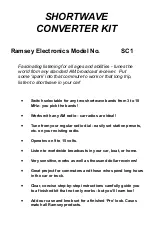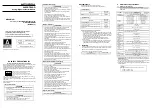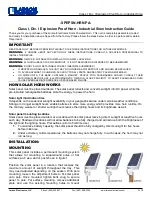
Blue Sky Energy - Solar Boost 1524iX
5
OPTIONAL TEMPERATURE COMPENSATION
The charge voltage required by batteries changes with battery temperature. Temperature compensation of charge voltage enhances battery
performance and life, and decreases maintenance. Automatic temperature compensation can be provided using the optional battery temperature sensor
(BSE p/n 930-0022-20). The default compensation factor of –5.00mV/
°
C/cell is appropriate for most lead-acid batteries.
FACTORY DEFAULT CHARGE VOLTAGE SETPOINT -VS.- BATTERY TEMPERATURE
FIGURE 2
MAXIMUM SETPOINT VOLTAGE LIMIT
Regardless of setpoint values entered by the user or result from temperature compensation the 1524 will not apply a charge voltage setpoint greater
than the maximum voltage setpoint limit factory configured to 15.5/31.0V. Note that actual battery voltage may briefly exceed this value by 0.1 – 0.2V as the
voltage control servo responds to changes in load.
MAXIMUM POWER POINT TRACKING (MPPT)
Patented MPPT technology can extract more power and increase charge current up to 30% or more compared to conventional controllers. The
principal operating conditions which affect current boost performance are PV array temperature and battery voltage. At constant solar intensity, available PV
voltage and power
increase
as PV temperature
decreases
but it takes an MPPT controller to access this extra power. When PV voltage is sufficiently high in Bulk
for MPPT to operate, a
constant power
output is delivered to the battery. Since output power is constant a
decrease
in battery voltage produces a further
increase
in charge current. This means that the 1524 provides the greatest charge current increase when you need it most, in cold weather with a discharged battery. In
cool comfortable temperatures most systems see about 10 – 20% increase. Charge current increase can go to zero in hot temperatures, whereas charge current
increase can easily exceed 30% with a discharged battery and freezing temperatures. For a more complete MPPT description see
www.blueskyenergyinc.com
.
PANEL TEMPERATURE AND OUTPUT POWER
Internal power control devices use the front panel as a heatsink. It is normal for the front panel to become quite warm to the touch when the unit is
operating at high power. When mounted vertically as described in the installation section, the unit can deliver full output in an ambient temperature of up to
50
°
C (122
°
F). If an over temperature condition exists, the unit will shut down and the Charge Status Indicator will display an OFF condition. The 1524 does not
include a digital type temperature sensor and will always show the heatsink to be –55
°
C on the IPN-ProRemote.
MULTIPLE CHARGE CONTROLLERS ON THE IPN NETWORK
The IPN network architecture allows multiple charge controllers to operate as a single charging machine. Up to 8 IPN compatible charge controllers
can reside on a single network and can share a single display and battery temperature sensor. Charge controllers can be added to grow a small system into
a large system and have this large system operate from the users standpoint as a single charge controller.
INSTALLATION
¾
WARNING:
Read, understand and follow the Important Safety Instructions in the beginning of this manual before proceeding.
This unit must be installed and wired in accordance with National Electrical Code, ANSI/NFPA 70. Over current protection must be
provided externally. To reduce the risk of fire, connect to a circuit provided with 20A maximum branch-circuit over current protection
(25A with 12V battery and 12V PV modules) in accordance with National Electrical Code, ANSI/NFPA 70. Do not connect a PV
array capable of delivering greater than 12A of short circuit current I
SC
at STC (16A with 12V battery and 12V PV modules). Do not
connect BAT– and PV– together external to the unit. The unit is not provided with a GFDI (ground-fault detector/interrupter) device
and must be used with an external GFDI device as required by Article 690 of NEC for the installation location. To reduce risk of
electric shock, remove all sources of power before installing or servicing. Figures 3, 4 and 5 show generalized connections only and
are not intended to show all wiring, circuit protection and safety requirements for a photovoltaic electrical system.
¾
CAUTION:
The 1524 is protected against reverse battery and PV polarity, and swapped PV and battery connections, but will be
damaged by reverse battery to the PV terminals. Transient voltage lightning protection is provided, but steady state voltage in
excess of 57VDC on the battery or PV terminals will damage the unit. Damage of either type voids the limited warranty.






























